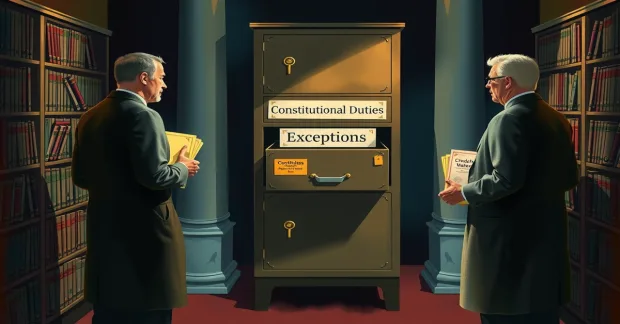
Many of us signed “standard” contracts and I was trapped by a non-compete that stripped me of my right to work; now I warn you: does your clause quietly stop you from earning or force you to choose poverty over litigation? I’ll show how employers weaponize fear, how courts and the FTC may void abusive agreements, and what steps you can take to reclaim your career and protect your livelihood.
Key Takeaways:
- Ask yourself: Do they own my future? I signed a “standard” contract and later discovered my non-compete could legally bar me from working in my field — my employer kept control of where I could earn after I left.
- Fear is their quiet weapon. I felt paralyzed by the threat of lawsuits, blacklisting, and shame; non-competes rely on psychological control as much as legal teeth to keep you compliant.
- Hidden and widespread harm. I found out over 30 million U.S. workers are bound by these clauses and that they can suppress wages (roughly 5–10%) and block career mobility.
- Law and hope differ by location. My options depended on state law — some states ban non-competes, others enforce them — and the FTC’s proposed nationwide ban could help many but faces big legal fights. Consult an employment attorney about your situation.
- Don’t be silenced; take action. I documented coercion, sought legal advice, tracked regulatory updates, and spoke up — overly broad or secretly imposed non-competes can often be challenged or neutralized.
Understanding Non-Compete Clauses
I dug into dozens of contracts and found the same pattern: buried language that can lock you out of work. Studies show over 30 million U.S. workers are affected, and regulators are fighting back—the FTC’s 2025 ban aims to void many agreements. I learned the hard way that clauses vary wildly in scope, duration, and enforceability, so your next move depends less on the paper and more on where you live and the lawsuit risk your employer is willing to take.
Definition and Purpose
A non-compete is a contractual promise limiting your ability to work for competitors or start a similar business for a set time and area. Employers claim it protects trade secrets and client relationships; in practice durations commonly range from 6 months to 2 years, though some clauses stretch farther. I saw one retail clause that barred me from a 50-mile radius—designed to protect customers, but it really protected market share, not proprietary technology.
Common Misconceptions
Many believe non-competes only hit execs or protect real secrets—wrong. They’re often slapped on entry-level and low-wage roles, and they can suppress wages by an estimated 5–10%. Employers tell you signing is standard; I was told the same, then later threatened litigation when I tried to leave. Courts don’t automatically enforce every clause; enforceability depends on overbreadth, consideration, and state law.
I’ve watched three myths play out: that signing is voluntary, that every clause is enforceable, and that courts always strike whole agreements down. In reality, I was pressured to sign under threat of job loss—classic coercion—and employers often lean on the blue pencil doctrine so judges can rewrite clauses instead of voiding them, keeping you tethered while giving the company legal cover.
Variations Across States
Enforceability is a patchwork. States like California, North Dakota, and Oklahoma ban non-competes outright, while places such as Illinois, Virginia, and Washington impose heavy restrictions. Many courts apply different tests—some void overly broad terms, others trim them—so the same clause can be enforceable in one state and worthless in another. I learned that your address matters as much as the contract language.
State statutes also target specific workers: several jurisdictions bar non-competes for low-wage employees or require clear notice and consideration to be valid. Meanwhile, employers in restrictive states sometimes rely on confidentiality or nonsolicitation clauses instead. I tracked changes in my state and found enforcement trends shift quickly—another reason to check local law or consult counsel before assuming your clause is safe or enforceable.
The Mechanics of Non-Compete Agreements

I’ve read dozens of these clauses and can tell you they’re engineered to sound neutral while doing maximum harm: they swap simple phrases like “protect trade secrets” for sweeping bans, lock in multi-year restrictions, and wrap geographic bars that can be statewide or nationwide, effectively controlling your livelihood long after you leave.
Typical Language Used
I signed a clause that promised to protect “confidential business information,” yet it also included broad terms like “any customer, prospect, or market”, vague duties tied to “company goodwill,” and blanket prohibitions labeled as reasonable—language courts often parse against you unless you push back.
Duration and Geographic Limitations
Employers commonly demand anywhere from 6 months to 2 years; I saw a two‑year, nationwide bar that blocked me from working in half the country. Courts tend to favor shorter periods for rank‑and‑file workers and stricter scrutiny when the geographic scope reads like a map of the employer’s competitors.
In practice, duration matters: many jurisdictions treat anything over one year as suspect for non‑executives, while tech roles often see 6–12 month limits. Geographic breadth also determines enforceability—statewide or national bans are trimmed or struck down more often than city‑level limits. I fought a clause that used the term “any territory served”, and my lawyer pointed to cases where judges applied the blue‑pencil to cut scope rather than rewrite intent.
Enforceability Factors
Courts weigh several elements: whether the employer shows a legitimate business interest, whether you received valid consideration, the reasonableness of time and geography, and your role or salary—lower‑paid staff face tougher enforcement hurdles but aren’t immune.
- Legitimate business interest
- Consideration
- Reasonableness (time & scope)
- Employee role & salary
- State law differences
- Blue‑pencil vs. reformation
Judges look at precedent: in California and certain rulings, broad non‑competes collapse; in other states, courts will trim overreach. I learned the hard way that showing coercion, lack of disclosure, or minimal consideration (no bonus, no promotion) can flip a case. Perceiving the real test courts use—balancing employer harm against your right to earn—changed how I documented my exit and prepared evidence.
- Precedent & jurisdiction
- Public policy considerations
- Evidence of coercion or duress
- Scope vs. necessity
- Availability of narrow tailoring
The Rationale Behind Non-Competes
I’ve seen employers frame non-competes as necessary shields for R&D, client lists, and training investments, claiming they prevent costly poaching; yet with over 30 million workers bound and studies showing a 5–10% wage suppression, that stated rationale often masks control, not protection.
Business Interests and Protection
Companies insist non-competes defend intellectual property and customer relationships—think sales reps with sensitive accounts or engineers on proprietary systems—but I was told my client lists were “company property.” That justification lets firms insert vague language and impose broad, multi-state bans that restrict where you can work long after you leave.
The Argument for Employee Security
Employers tell you non-competes create stability and justify training and benefits by reducing turnover; I heard that line when mine was enforced: “It’s for your security.” In practice, though, those clauses frequently block higher-paying offers and career moves, turning supposed security into economic captivity.
In my case the clause barred me for 12 months inside a 50-mile radius—typical terms in many disputes. Some judges use the “blue pencil” to trim excess, while the FTC’s 2025 proposal aims to void most such agreements; until then, that promise of security can cost you raises, clients, and momentum.
Employee vs. Employer Perspectives
From my view the clause felt like control; employers call it risk management. You feel the mobility loss and missed offers while they point to reduced turnover and protected margins. That gap—backed by the 30 million figure and wage studies—shows who actually benefits.
I watched colleagues in healthcare, retail, and tech get sidelined by similar clauses while companies kept talent locked in. States that ban or restrict non-competes—like California, North Dakota, and Oklahoma—see more mobility and startups, which suggests these contracts often protect profit margins at the expense of your career options.
Trends in Non-Compete Usage
I’ve watched non-competes spread like a quiet infection across job types, and you’ve probably seen it too: what used to be limited to senior execs now shows up in offer letters for servers and coders alike. Studies put the number at over 30 million workers bound by these clauses, and I felt that chokehold when I couldn’t take a better-paying job without risking a lawsuit—so ask yourself, is your contract secretly stealing your next paycheck?
Growth Across Industries
Companies in hospitality, healthcare, construction, and staffing are adding non-competes where none existed a decade ago; franchise restaurants and retail chains increasingly include them in handbooks. I saw a contractor forced to sign a clause after an acquisition, and you should know this trend isn’t limited to high wages—these clauses now target low-paid roles, widening the reach of corporate control and contributing to an estimated 5–10% suppression in wages nationwide.
High-Tech and Trade Secrets
Tech firms frame non-competes as protection for trade secrets, yet cases like Waymo v. Uber show courts care more about theft than broad employee restrictions; I watched engineers accept limits that blocked them from working in entire metro areas. If you work in software, your employer will often use vague definitions—like “proprietary knowledge”—to justify restraints that go far beyond real risk.
Digging deeper, I found companies labeling common skills and client familiarity as trade secrets so they can lock out talent; startups then struggle to hire when ex-employees are legally sidelined. You should know that in states like California non-competes are void, so employers switch to aggressive NDAs and no-poach agreements to get similar results—leaving you exposed to litigation or forced career pauses even when you did nothing wrong.
The Impact on Gig Economy Workers
Platforms and staffing agencies increasingly add clauses that function like non-competes—drivers, couriers, and freelancers report being told they can’t work for rivals for months after leaving. I experienced the panic of a delivery driver friend who was blocked from switching apps mid-month; that fear keeps gig workers tied to low pay and unpredictable hours.
On closer look, these clauses often masquerade as confidentiality or arbitration terms to bypass scrutiny, and enforcement against independent contractors is messy but intimidating. You should be aware that the FTC targeted restrictions that harm gig workers, and while legal battles continue, the immediate effect is clear: you face legal uncertainty, reduced bargaining power, and the real possibility of lost income if you try to move freely.
The Psychological Impact on Employees

I felt the weight of a clause long before I saw a courtroom — and you probably do too: over 30 million American workers are tethered to contracts that breed anxiety, second-guessing, and stalled decisions. I watched coworkers pass on promotions or relocate for family because the non-compete made the risk seem too high; you learn to budget fear the way you budget rent, and that emotional tax shows up as lost opportunity and quieter, long-term career damage.
Fear of Legal Repercussions — Have you ever feared a lawsuit?
I delayed accepting a higher-paying offer because I worried a company would sue; in practice, employers often threaten litigation even when clauses are unenforceable. Litigation can cost employees tens of thousands in defense, ruin credit from unpaid legal fees, and force people to take lower-paid roles to avoid courtroom risk. When you feel one wrong email could trigger a suit, your career choices shrink dramatically.
The Effect on Career Mobility — Is your next move already blocked?
I lost a clear path to a promotion because my non-compete barred me from joining a rival within 50 miles; studies show non-competes suppress wages by an estimated 5–10% and bind millions of workers to stagnant roles. You start declining offers, avoiding startups, and passing on entrepreneurship because the clause makes every advancement feel like a legal gamble.
More than anecdotes, the data and legal patchwork explain why mobility collapses: companies in tech, healthcare, construction, and beauty all use these clauses, and courts sometimes apply the “blue pencil” fix rather than voiding harmful terms. In states like California, North Dakota, and Oklahoma non-competes are void, but in most states enforcement persists, meaning your ability to move can depend on zip code, judge, and your willingness to fight—something few can afford. I’ve seen talented people leave their fields entirely rather than risk a lawsuit or a job they can’t market.
Emotional Manipulation in the Workplace — Do they guilt you into staying?
I was told signing the clause proved “loyalty,” and it felt like emotional blackmail; employers use guilt, praise, and performance reviews to keep you compliant. That manipulation isn’t soft power — it’s deliberate: labeling departure as disloyal, implying blacklists, or celebrating “team unity” while locking your future. When emotional pressure combines with legal threat, you stop seeing options and start protecting a job that no longer serves you.
Digging deeper, companies weaponize culture to make legal restraints feel moral: HR scripts frame non-competes as career protection while managers link raises to “commitment.” Surveys and case reports show higher anxiety and job insecurity among workers under restrictive covenants, and I experienced colleagues reporting sleeplessness, health issues, and stalled savings plans because they feared being painted as traitors. Ultimately, the emotional playbook—guilt, shame, subtle threats—keeps people trapped far more effectively than any signed page.
The Legal Landscape of Non-Competes
Key Court Cases and Precedents
I tracked landmark rulings like Edwards v. Arthur Andersen and saw judges use the blue pencil doctrine to trim clauses rather than void them, which often protects employers more than workers. I watched courts uphold non-competes for high‑level executives while tossing similar clauses for rank‑and‑file employees, and I can tell you the result: millions remain shackled despite precedent that could free them.
Variability by State: A Comparative Analysis
I lived this: in states like California, North Dakota, and Oklahoma non‑competes are effectively banned outright, while places such as Illinois, Virginia, and Washington have heavy restrictions; most other states still enforce broad covenants. Ask yourself: if you move across state lines, does your right to work travel with you? Often it does not.
I moved between jurisdictions and learned the hard way that state law changes everything — enforcement, remedies, and employer leverage shift dramatically. In California the clause was a non‑starter; in another state an identical clause threatened my livelihood. That inconsistency lets employers forum‑shop and keeps you guessing about whether your next job will be lawful or litigated.
State | Typical Rule
| State | Rule/Note |
|---|---|
| California | Non‑competes generally void; strong worker protections. |
| North Dakota / Oklahoma | Banned outright for most employees. |
| Illinois / Virginia / Washington | Heavily restricted; statutory limits and notice requirements. |
| Texas / Florida / New York | Enforceable if reasonable in time, scope, geography. |
| Most other states | Varied standards; many still favor employers in practice. |
Current Legislative Challenges
I followed the FTC’s 2025 non‑compete ban closely, and you should too: big employers and trade groups are suing to block it, claiming agency overreach and constitutional problems. Meanwhile, millions of workers — an estimated 30 million — wait while litigation decides whether those clauses stay or go.
The fight is technical and political: opponents argue the FTC lacks authority and cite separation‑of‑powers concerns, while proponents point to economic studies showing wage suppression and reduced mobility. If courts delay enforcement, the practical effect could be years of uncertainty; if the ban stands, many existing clauses could be declared void and employers forced to notify affected workers.
The Role of the FTC and Government Regulation
The FTC’s push to regulate non-competes isn’t theoretical — it targets the very clause that forced me out of work for months. With over 30 million workers bound by these agreements, the agency argues they’re an unfair, anticompetitive practice that suppresses wages and mobility; employers are fighting back with lawsuits, but the rule’s potential to void existing clauses could immediately change how my career — and your next job — plays out.
Overview of FTC’s Proposed Changes
The 2025 proposal would void existing non-competes for most workers, ban new ones nationwide, and require employers to notify affected employees they’re free to work elsewhere. The FTC frames this as restoring competition; critics call it regulatory overreach. I watched employers scramble: some quietly rewrote contracts into NDAs or non-solicits, while trade groups filed suits to halt enforcement.
Implications for Workers’ Rights
If the ban holds, workers like me could reclaim lost opportunities: studies show non-competes depress wages by about 5–10% and block millions from switching jobs. States already banning these clauses — California, North Dakota, Oklahoma — offer a preview: higher mobility, faster rehiring after layoffs, and more startups from once-restrained employees.
More directly, enforcement could produce immediate relief: employers might be forced to rescind or settle existing agreements, spawning class actions and reopening cases where workers were denied work. I know colleagues who’d have taken better jobs if not for fear of litigation; a nationwide rule paired with state enforcement could create pathways for back pay, easier whistleblower claims, and reduced legal intimidation that currently chills employees from reporting abuses.
The Future of Employment Contracts
Employers will adapt fast: expect tighter NDAs, non-solicit clauses, and “garden leave” pay as substitutes, plus sharper arbitration and confidentiality language to protect companies while skirting bans. I’ve seen firms pivot to creative drafting the week after policy leaks — the legal battlefield will shift, not vanish.
More change is likely: courts may police overly broad non-solicits, and legislators could carve exceptions for senior executives or sale-of-business deals, so you’ll still need to read every line. I advise documenting coercion and seeking legal review before signing; practical shifts mean employers will test limits, and your best defense is evidence, state-law knowledge, and quick legal counsel to challenge hidden restraints.
Industry Reactions and Responses

I watched industries scramble: major firms and trade groups launched multiple court challenges to the FTC ban while politicians and lobbyists stoked fear about lost “innovation.” At the same time I keep pointing readers to analysis that warns there’s often only one real reason to sign a non-compete — Only 1 reason to sign Non-Compete Agreement — even though over 30 million workers are affected and wages drop an estimated 5–10%.
Corporate Pushback Against Regulation
I’ve seen corporations argue the FTC rule is unlawful while filing multiple lawsuits, claiming bans will harm R&D and franchising; yet the data shows non-competes often protect market share, not innovation. In practice courts sometimes apply the “blue pencil” approach, trimming clauses instead of voiding them, which keeps workers trapped despite regulatory fights.
Small Business Perspectives
I hear conflicting views from small owners: some tell me they need non-competes to protect client lists and recoup training costs, while others warn those clauses make hiring impossible and scare away talent. For many local employers the question becomes: do you protect an investment or suffocate your labor market?
I dug deeper and found practical workarounds: many small businesses in banned states now use targeted non-solicit agreements, confidentiality pacts, or short garden-leave terms to protect assets without risking litigation; a café owner I know replaced a broad non-compete with a narrow confidentiality clause and kept her best barista.
Advocacy Groups Fighting for Reform
I follow worker advocates, legal clinics, and civil-rights groups that pushed state bans and fed evidence to the FTC, emphasizing how non-competes hit low-wage workers hardest. Their strategy pairs litigation, lobbying, and public campaigns to show the human cost: lost jobs, suppressed wages, and stunted entrepreneurship.
Those groups rely on hard numbers and case studies—highlighting the 30 million figure and the 5–10% wage impact—to win lawmakers and courts; I used their reports when I challenged my own clause and found their toolkits invaluable for building a practical defense.
Consequences of Non-Compete Agreements
I lived the fallout: non-competes don’t just hurt one career, they reshape local economies. With an estimated 30 million workers bound and wages suppressed by roughly 5–10%, what looks like a private contract becomes a public drag on mobility, earnings, and opportunity. I watched colleagues stay put because litigation fears or contractual bars made moving impossible—while employers kept talent, reduced competition, and raised profits at our expense.
Impact on Innovation and Entrepreneurship
I wanted to start a company but my agreement locked me out of the market for 12 months; investors told me a founder under a non-compete is a liability. Studies and my experience show non-competes blunt startup formation, stop knowledge spillovers, and push innovators to relocate or abandon projects—so while employers claim protection, the real effect is fewer new businesses and slower local innovation.
Detrimental Effects on Labor Markets
I felt labor markets tighten around me: non-competes reduce job-switching, lower bargaining power, and depress wages across sectors. With reduced mobility and employers holding leverage, workers accept worse terms or a pay cut to avoid lawsuits. The FTC’s 2025 action targets this exact imbalance because these clauses distort hiring, keep salaries stagnant, and concentrate market power.
I saw the mechanics firsthand: HR refused counteroffers, recruiters stopped calling once they learned of my clause, and competing firms wouldn’t risk hiring me. That’s not hypothetical—this legal friction increases search costs for both workers and employers, prolongs unemployment spells for those trying to pivot, and funnels skilled labor into fewer firms. In practice, it means slower wage growth, fewer matches, and a less dynamic local economy.
Real-Life Stories of Worker Exploitation
I was coerced into signing under threat of losing my job; others I know—nurses, tech support, hairstylists—were told the same. Employers frame non-competes as routine, but in reality they extract concessions: lower raises, restricted freelancing, and threats of litigation. The result is a pattern of exploitation where workers trade future freedom for immediate employment security.
After I left, my former employer threatened court action and I spent weeks negotiating a release; defending even small claims often costs tens of thousands in legal fees and destroys savings. I’ve met people who shelved entire career plans, relocated, or accepted huge pay cuts to avoid being sued. These are not isolated tales—they’re the daily consequences when contracts trump livelihoods.
Strategies for Employees

I learned to attack non-competes with a checklist: document coercion, verify state bans (California, North Dakota, Oklahoma), and press HR for narrow duration and limited geographic scope. With over 30 million workers tied to these clauses and the FTC 2025 rule pending, you can demand compensation or a written carve-out for side work; track onboarding dates and save emails — those details win challenges.
Tips for Negotiating Non-Compete Clauses
When I negotiated, I pushed for clear limits: cap length at 6–12 months, narrow industries, and explicit exceptions for clients I already served. Ask for garden leave or a buyout option and cite competing offers to establish leverage. Courts often trim vague clauses, but employers prefer settlement to litigation. Recognizing leverage at hiring, I demanded a written carve-out for freelance work and a salary supplement during any restricted period.
- Limit duration to 6–12 months
- Restrict geographic scope to specific markets or zip codes
- Narrow scope to defined roles or direct competitors only
- Require compensation or garden leave during restriction
- Include a clear carve-out for pre-existing clients and side gigs
Understanding Your Rights
I checked state law and found stark differences: California, North Dakota, and Oklahoma ban most non-competes, while other states still enforce broad covenants. If you signed without new pay or a promotion, lack of consideration can void a clause. Collect start dates, offer letters, and any coercive messages — courts weigh those facts when judging overbroad scope or disproportionate duration.
In my case the judge applied the blue pencil approach and trimmed a three-year ban to 12 months; other judges void clauses outright when they conflict with public policy. You can attack enforceability by showing no legitimate trade-secret interest, low wages, or evidence you were forced to sign. Compare your clause to state statutes, document pay and duties, and use those records—I found that concrete timelines and emails shift outcomes in most successful challenges.
Seeking Legal Counsel
I hired an employment attorney after a free consult; many firms offer initial reviews at no charge and work on contingency or flat fees. Expect experienced counsel to bill roughly $250–$600/hr, though plaintiff firms often take cases on contingency when damages justify it. Use state bar referrals, legal clinics, or nonprofit organizations if cost is a barrier, and bring your contract, pay records, and threatening messages so the attorney can assess enforceability immediately.
An attorney can send a demand letter, pursue a declaratory judgment, or negotiate a buyout; litigation pressures employers because discovery often exceeds tens of thousands of dollars. I saw employers choose a $20,000 buyout over protracted suits. Ask about timelines (many cases settle in 3–12 months), fee structure, and prior wins in your state; if money’s tight, negotiate capped fees, payment plans, or contingency arrangements for a path forward.
Breaking Free from Non-Compete Agreements
I felt trapped until I learned to treat a non-compete like any other legal threat: investigate, document, and push back. Start by scanning your clause for duration, geography, and scope, then collect emails, offer letters, and any proof you were pressured to sign. I found that combining a written record with a quick attorney consult and state law checks — for example, noting that California, North Dakota, and Oklahoma ban non-competes — changed my leverage overnight. Do you feel like your next paycheck is hostage?
Identifying Potential Loopholes
I always look for common escape hatches: no new consideration (you weren’t paid or trained for it), overly broad duties, or an indefinite time frame. Courts routinely trim or void clauses that impose a 5-year, nationwide ban on a mid-level employee; that’s a red flag. Also check whether the agreement conflates non-solicitation or confidentiality with a true non-compete—those differences can be your out. Have you checked whether your duties are even defined?
Steps to Challenge a Non-Compete
I recommend a clear route: review the clause, preserve all communications, get an employment attorney, then demand narrow, written carve-outs or file for declaratory judgment if necessary. Move fast when you have an offer on the table—courts can issue emergency injunctions within days. In practice, I used targeted evidence of duress and lack of consideration to force negotiation; many workers find negotiation or a motion to dismiss ends the threat without long litigation.
More specifically, argue doctrines like lack of consideration (no raise, training, or promotion tied to the agreement), duress (sign-or-lose-job threats), unconscionability, or public-policy conflicts. Use the blue pencil doctrine to push judges to narrow an overbroad clause rather than enforce it whole. If litigation starts, seek fee-shifting or settlement terms that buy you a short carve-out (e.g., work allowed outside a 10-mile radius) while preserving future options.
Utilizing State-Specific Resources
I turned to state agencies and local bar referral services when my employer threatened suit. Your attorney general’s website, state labor departments, and bar association referral lists often publish guidance, sample complaints, and free clinics. Since laws vary — and California’s §16600 or bans in North Dakota and Oklahoma can be absolute defenses — checking your state’s resources gives you immediate, practical options instead of guessing.
Dig into your state code and AG opinions: some states (Illinois, Virginia, Washington) have strict limits or disclosure rules; others void non-competes outright. I used a free 30-minute bar consult to confirm which statutes applied, then downloaded sample demand letters from my AG site. If you can, find a local legal clinic or nonprofit that handles employment disputes—many provide free or low-cost representation that flips the power back to you.
The Future of Non-Competes: What’s Next?
I’ve watched the legal ground shift fast: with the FTC’s 2025 rulemaking, state bans in California, North Dakota, and Oklahoma, and litigation from big employers, the battlefield is changing for the estimated 30 million workers bound by non-competes; if the federal effort survives courts it could void existing clauses for most employees, force employer notices, and reshape hiring practices within months.
Predicting Legislative Changes
I expect layered outcomes: some states will expand bans, others will tighten restrictions while courts parse the FTC’s authority; given studies showing non-competes suppress wages by 5–10%, lawmakers face pressure to act, yet trade groups are already suing—so you should watch rulings in 2025–2026 that will determine whether bans are immediate or gradually implemented.
The Shift in Employer-Employee Dynamics
Having been constrained myself, I see employers adapting: many replace blunt non-competes with non-solicit clauses, stricter NDAs, or offer garden leave and severance to deter departures, while others try reclassifying roles or tightening IP assignment to maintain control without an explicit non-compete.
In practice I’ve seen three clear strategies: companies in tech and healthcare increasingly use narrowly tailored non-solicit and confidentiality terms to survive court scrutiny; low-wage employers lean on arbitration and threat letters to intimidate; and some firms now pay “mobility stipends” to legally limit litigation risk—so you must read every clause and compare alternatives like severance-for-freedom offers.
A Vision for a Fairer Work Environment
I want a landscape where your skills aren’t property: policies that ban broad non-competes, require employer notice, and offer clear alternatives would restore mobility; if lawmakers follow data and the FTC’s agenda, millions could regain the right to change jobs without fear of litigation or lost wages.
Specifically I argue for statutory limits: voiding non-competes for low- and mid-wage workers, mandating employer disclosure at hiring, and promoting enforceable garden leave or reasonable compensation instead of blanket bans—practical reforms that reduce litigation, protect trade secrets through targeted NDAs, and let you rebuild a career without corporate chains.
Realizing Your Freedom and Rights
When I finally challenged my clause I learned harsh truths: over 30 million U.S. workers are affected and non-competes can cut wages by an estimated 5–10%. Ask yourself: do you want your employer deciding your future? I tracked state bans (California, North Dakota, Oklahoma), followed the FTC’s 2025 moves, and read debates like Is a non-compete agreement enforceable simply because … to see how enforceability is contested.
Empowerment Through Knowledge
I started by mapping my state’s law and found courts often use the blue pencil to save clauses, not strike them down; that changed my strategy. I read case law, used state labor sites, and asked an employment attorney who pointed out how duress, vague scope, or no consideration can make a clause unenforceable—so I compiled dates, emails, and pay stubs to build my case.
Building a Support Network
I reached out to former colleagues, a local employment attorney, and an online forum for affected workers; within weeks I had witnesses, document reviewers, and moral support. Strong alliances—trade unions, state AG hotlines, and peer groups—turned what felt like isolation into collective power that helped me negotiate and, ultimately, push back.
I expanded that network by attending two local legal clinics, joining a Slack group of 400+ workers in my industry, and connecting with a nonprofit that files strategic litigation. Those steps gave me sample complaints, template demand letters, and a timeline for escalation—so I wasn’t guessing, I was following proven moves other plaintiffs used successfully.
The Role of Technology in Emancipation
I used contract-scanning tools to flag overly broad terms, timestamped communications, and cloud backups to preserve evidence; digital tools turned vague threats into concrete, provable facts. With services like online legal marketplaces and state statute databases, I saved hundreds on research and found targeted counsel faster—technology multiplied my reach and reduced my risk.
Practically, I relied on encrypted storage for sensitive files, screen-recorded onboarding sessions that referenced the clause, and law-search engines to pull precedent. I also used LinkedIn to document my work history and Git commits as proof of independent projects—those digital footprints made it harder for employers to claim exclusive ownership of my skills.
Conclusion
Summing up, I lost years of opportunity to a non-compete that silenced my career and nearly ruined my finances, so I speak plainly: you deserve to know if your employer is claiming ownership of your future — do you want a contract to decide where you can earn and live? I urge you to review your agreement, document coercion, and consult counsel; I fought back and found options, and you can too.
FAQ
Q: Can one paragraph in a “standard” contract quietly steal my livelihood — did that happen to me?
A: Yes. I signed what I thought was routine and later discovered a non-compete that barred me from working in my field for a year across multiple states. Non-competes typically restrict three things: the duration (months or years), the geographic reach (city, state, nationwide), and the activities or roles you’re forbidden from doing. Enforcement depends on state law: some states ban them outright, others limit scope, and many still enforce broadly written clauses. If you’re reading this, check the exact language — vague “business interests” or blanket bans on “competition” are red flags. My first actions were to save the contract, note who presented it and when, and consult an employment attorney to assess enforceability under local law.
Q: Was I forced to sign — and does that make the non-compete invalid? How did coercion feel when it happened to me?
A: I was told “sign or lose the job,” and it felt like I had no choice. Coercion or duress can void an agreement if you can prove you were threatened, misled, or had no real ability to negotiate. Other defenses include lack of consideration (did you get anything in return?), fraud, or that the clause is unconscionable or overly broad. Document everything: emails, who said what, timing, and any promised concessions. In my case, a follow-up attorney argued I signed under economic duress because the clause was sprung on me at the last minute and I had no alternative offer — that evidence made the clause negotiable.
Q: Should I hide my job search because I’m terrified of getting sued — what happened to me when I tried to move on?
A: I was terrified and almost stopped looking. Employers do sometimes sue to intimidate, even if they don’t ultimately win. The real risk depends on how broad your clause is and whether your new role uses alleged “trade secrets.” Practical steps I took: get legal advice before accepting a new job, avoid using or sharing confidential materials, and discuss the new role with counsel to see if it’s outside the prohibited activities. Sometimes a small change in duties, title, or geography avoids conflict. In my case, my lawyer negotiated clear role language with the new employer and secured indemnity language that reduced the risk of an aggressive lawsuit.
Q: Can I buy my freedom or get the clause narrowed — how did I escape without years of court fights?
A: I negotiated a way out. Options include asking for a written release, negotiating a buyout or garden-leave pay, narrowing the scope (shorter time, smaller geography, limited activities), or trading the non-compete for a non-solicitation or confidentiality clause that’s easier to enforceably defend. Some employers will accept a severance payment in exchange for a release. If negotiation fails, check statutory protections where you live — some states void these clauses for low-wage workers or limit them by profession. Also watch federal developments: proposed bans and agency actions may affect existing agreements. My escape combined a negotiated buyout with a narrowed covenant and a written release, all reviewed by counsel.
Q: How do I protect my family, sanity, and finances while I challenge or escape a non-compete — what did I do when panic set in?
A: I felt trapped, sleepless, and ashamed — which made everything worse. Protect yourself emotionally and financially: build a short emergency fund, discreetly expand your network, and look for roles that don’t trigger the clause while you resolve things. Document every interaction with your employer and preserve copies of handbooks and offer letters. Seek free or low-cost legal clinics, local worker-advocacy groups, or bar association referrals; many lawyers will do an initial consult at low cost. Tell only trusted people about your strategy; fear of being blacklisted is real, so keep sensitive details limited. I also negotiated part-time consulting within safe boundaries to pay bills while my attorney pushed for a release — practical steps that kept me afloat and sane while the legal side played out.




















